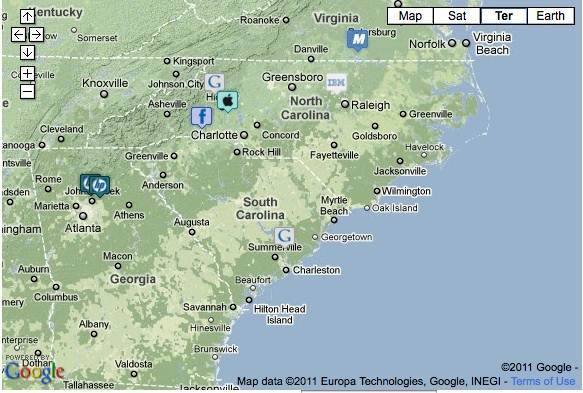Justin Murphy (Geographer), May 14, 1975, Perth: […] Could I ask you very simply? You suggest this. If we all do this, will that, for example, remove the problems that we do, that our society, at any rate, at any guess, generates for ourself? We have more and more pollution. Depending on the way the wind blows, for example, we get at times choking pollution from the industrial complexes down to the south of this city. Are these problems going to be…
Prabhupada: No, no, the next question will be, “If you get sufficient grain for eating, why should you take to industry?” Full conversation
The Dirty Data Triangle of North Carolina | GREENPEACE
Blogpost by Jodie Van Horn | GREENPEACE | April 28, 2011 at 18:40 |
North Carolina now has three three-of-a-kind regions: the Triad, the Research Triangle and the Dirty Data Triangle.
The dirty what?
That designation comes courtesy of Greenpeace, the environmental organization, and it refers to the huge data centers – a.k.a. server farms – built or being built in Western North Carolina for California-based Apple, Facebook and Google.
Google came first. The Internet giant has a $600 million data center up and running in the Caldwell County city of Lenoir. Apple’s center, described as a $1 billion project, is nearing completion in the Catawba County town of Maiden. Facebook last year chose a site in Forest City, in Rutherford County, for a $450 million facility.
The longest leg of this emerging triangle is about 45 miles. What’s the “dirty” part? Coal, mainly.
Power hogs
Server farms consume enormous amounts of electricity. One guesstimate is that Apple’s facility will eventually use 100 megawatts – enough to power 80,000 houses. And Google, Apple and Facebook all draw their power from Charlotte-based Duke Energy.
Much of that power is generated by burning coal. It comes from Appalachian mines, both underground and “mountaintop removal.” Burning it, even in the cleanest of current-day generating plants, emits pollutants and carbon dioxide, a greenhouse gas.
It’s hardly an accident that Facebook’s facility will be only about 10 miles from Duke’s Cliffside Steam Station, west of Charlotte. There, Duke is gearing up Unit 6, an 825 megawatt plant, to open in 2012. The new unit will operate more cleanly than the old coal plants Duke commendably intends to shut down once it’s built, but Unit 6 is still a coal-burner. And the bulk of the non-coal power that the data centers will consume comes from Duke’s nuclear plants. To Greenpeace, nuclear is “dirty” as well – although that case is more controversial.
What’s unquestioned is Duke Energy’s central role in luring the data centers with promises of reliable, low-cost electricity. On a Duke website one executive is quoted as saying, “The great thing about a data center is that they run full-out, 24-7, with no shifts and no seasonality. It’s the type of customer where the meter spins and spins at an exponential pace.” Another Duke executive added, “We fully expect Apple to be one of our top ten customers in the Carolinas.”
Well, electric utilities sell electricity – so what? For North Carolina ratepayers and utility regulators, however, there’s the serious issue of meeting demand for electricity in a growing state. If Duke is actively scouting up huge new customers (which, as it happens, have relatively few employees compared to most manufacturing companies), how should citizens and regulators evaluate claims that the utility needs expensive new generating capacity? Or, for that matter, how should they respond to persistent calls to conserve?
So far, the discussion about North Carolina as an emerging data-center center has focused largely on the incentives state and local governments have lavished on the Internet companies that operate them. Yet it’s not necessary to see the world entirely as Greenpeace does to realize that it’s high time the megawatts are considered too.
Look out below!
Surely there’s something wrong with bulldozing West Virginia mountaintops into the adjacent valleys and streams in order to give North Carolina an advantage in attracting watt-guzzling data centers. We need to talk more about that, and we need to keep up the pressure for cleaner power.
In Oklahoma, where it’s building another data center, Google plans to buy 100 megawatts of wind-generated electricity. North Carolina may never have as many turbines as a state where the windpower comes sweeping down the plains. But nowhere is it written that our only edge should be cheap, dirty coal.
Once it completes its purchase of Progress Energy, Duke will dominate electricity generation and transmission in most of North Carolina. It will also become the nation’s largest electric utility. Before our state’s utility regulators sign off on that deal, we need to have a better idea of where Duke and the data centers are going.








Speak Your Mind